At A Glance | Homes for Sale | A Closer Look | Closing | Moving In | Realtor Resources
 Late 1700s: George Swain and his wife build a log cabin (historians debate if this is the same structure we see today) at or near its present site. They later invite George’s sister and her new husband, Joseph Lane, to live at the log cabin.*
Late 1700s: George Swain and his wife build a log cabin (historians debate if this is the same structure we see today) at or near its present site. They later invite George’s sister and her new husband, Joseph Lane, to live at the log cabin.*
Early 1801: The Swain’s son, David Lowry Swain, is born in the log cabin, where he lives until his late teens. He later is elected the 26th governor of North Carolina and heads the University of North Carolina for 33 years.*
Late 1801: David Swain’s cousin, Joseph Lane, is born in the log cabin. Years later, then General Lane is appointed by President James K. Polk as governor of the Oregon Territories.*
1900s: Two generations of the Collins family operate a dairy farm on much of the land that is Beaverdam Run today.
1967-1984: Mitchell Wolfson purchases the Collins’ farm and two smaller farms nearby for a horse stud farm, called Franlynn, after his wife and daughter. Wolfson is an owner of movie theaters and early TV stations, mostly in Florida, and also of WLOS-TV in Asheville, where he spends summers. He also owns land that eventually becomes the Asheville Country Club golf course. At Beaverdam Run, Wolfson builds the upper tennis court, the Japanese Garden (fed by two artesian wells), and the Hillside Pond, which is primarily supplied by storm water runoff and plays an important part in storm water management.
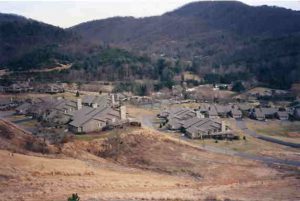 1985 – 1989: Ed Newmark, a New York music publisher, acquires the Franlyn farm after Wolfson’s death. He aims to build an upscale condo community. By 1988, he and his company, NWS Associates, build 66 units, along with a clubhouse, swimming pool, putting green and a second tennis court to attract buyers. However, the costs of building homes, carving roads and installing water and sewer higher up the mountain push Newmark to bankruptcy in 1989. The bank assumes ownership and, with no other options, resident volunteers run the condominium association. Their experience leads to the realization, and conviction, that the people in residence at Beaverdam Run are capable of managing the community – a belief that continues.
1985 – 1989: Ed Newmark, a New York music publisher, acquires the Franlyn farm after Wolfson’s death. He aims to build an upscale condo community. By 1988, he and his company, NWS Associates, build 66 units, along with a clubhouse, swimming pool, putting green and a second tennis court to attract buyers. However, the costs of building homes, carving roads and installing water and sewer higher up the mountain push Newmark to bankruptcy in 1989. The bank assumes ownership and, with no other options, resident volunteers run the condominium association. Their experience leads to the realization, and conviction, that the people in residence at Beaverdam Run are capable of managing the community – a belief that continues.
1989: The bank and the residents’ entity, Beaverdam Run, Inc., agree to hire developer Gerald Candler to finish the project. In addition to more homes, Candler builds Sunset Pond, uphill from Beaverdam Run. The pond helps manage storm water runoff before releasing it into the creek.
 1993: The Clubhouse is expanded to its current form.
1993: The Clubhouse is expanded to its current form.
1994: Asheville annexes Beaverdam Run against the wishes of most residents. In return for the added taxes, the community, already on city water and sewer service, receives greater fire and police protection, and waste removal.
1996: All homes in Beaverdam Run are completed and sold. The final units built are 1, 3, 5 and 7 Ridgeview Drive.
1997: The Beaverdam Run Condominium Association assumes full ownership and governance of the property.
2005: A new hillside community water tank, capable of holding 86,000 gallons, is installed to replace two existing tanks.
2010: Refurbishment of Beaverdam Run’s iconic Log Cabin begins.
2010 – 2011: New HVAC equipment enhances use of the Clubhouse and locker rooms.
2013: Locker room walls, ceilings and doors are repainted. In subsequent years, saunas and toilets are upgraded and the fitness room is enhanced with new flooring, lighting and exercise equipment.
2013-2014: Following heavy rains and flooding in July 2013, repairs are made to bridges, spillways, storm water pipes; retaining walls are built; and portions of Beaverdam Creek are stabilized.
2014: Major road repair and repaving begins; continues through 2017.
2015: Upgrades – exhaust fans and a new oven – make working in the Clubhouse kitchen even better.
2016: The lower tennis court is resurfaced and a new fence is installed. The upper tennis court is color coated; two portable pickleball nets arrive. A years-long effort begins to refurbish community streetlights and replace all bulbs with LED technology.
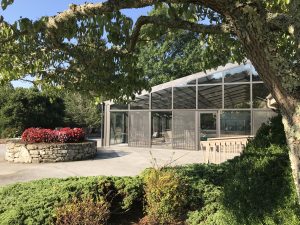 2017: Major refurbishment of the swimming pool launches. Over the next three years, a new enclosure is built, the pool deck is refinished, the pool interior is resurfaced and the steps are replaced. Internet service is introduced in the Clubroom.
2017: Major refurbishment of the swimming pool launches. Over the next three years, a new enclosure is built, the pool deck is refinished, the pool interior is resurfaced and the steps are replaced. Internet service is introduced in the Clubroom.
2018: Improvements to the Clubhouse continue. The Clubroom gets a new ceiling, ceiling fixtures and paint. A year later, Clubhouse hallways, ceilings and doors get a fresh coat of paint. Additional exercise equipment arrives in the fitness center. In 2020, a large flatscreen TV with surround sound is added.
2019 – 2020: New shrubs and oak trees, and a new split rail fence, along Beaverdam Road enhance the entrance to the community.
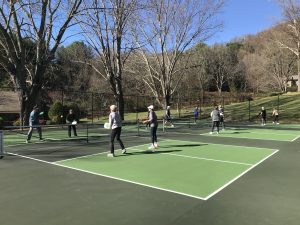 2020: The upper sports court is marked for four pickleball courts. A new entry gate and call system allow residents to more easily monitor and admit visitors. The Gazebo, where residents pick up mail, is redesigned and new mailboxes are installed.
2020: The upper sports court is marked for four pickleball courts. A new entry gate and call system allow residents to more easily monitor and admit visitors. The Gazebo, where residents pick up mail, is redesigned and new mailboxes are installed.
2021: The Association assesses the condition of the network of storm drains that manage water flow down Elk Mountain through the community and into Beaverdam Run. Many of the pipes — now more than 30 years old — are nearing the end of their useful life.
2022: The Association makes major investments in the property, both for residents’ enjoyment and long-term retention of value. These investments include:
• Extensive work to replace and re-line many old and damaged storm drains to protect against potential damage from flooding.
• Heating, ventilation and air conditioning improvements in the Clubhouse to promote greater comfort, control and energy efficiency — and a new gas heater in the pool area to improve comfort and better manage condensation.
• Modernization of fixtures, countertops, showers and flooring in Clubhouse locker rooms and bathrooms to create a more pleasant experience for residents and visitors.
• Enhancements to the community’s historic Log Cabin designed to promote year-round use. Improvements include the addition of a new gas furnace and air conditioning, a new sliding glass door, and new stair and upper-level carpeting, as well as the refinishing of first-level wood floors.
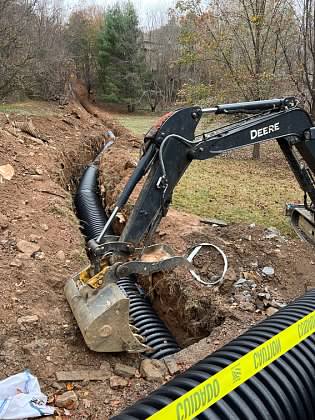

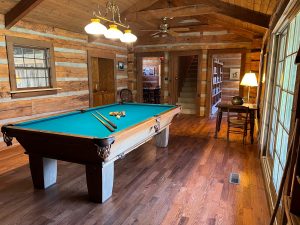
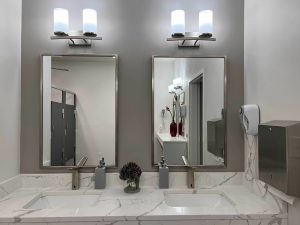

2023:
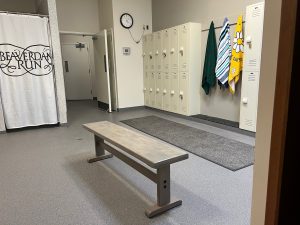 • New lockers are installed in Clubhouse locker rooms, continuing their modernization.
• New lockers are installed in Clubhouse locker rooms, continuing their modernization.
• Repairs are made to damaged Beaverdam Run streets, a first step in a project to repave most of the community’s streets in 2024.
2024:
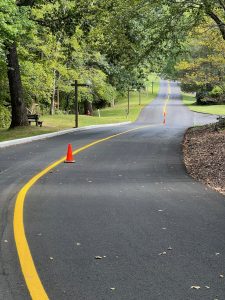 • Nearly all of Beaverdam Run’s almost five miles of streets are freshly paved — about 40 percent from the ground up; the rest milled, then topped with layers of stone, tar and asphalt. Most of the work is completed just before the arrival of Tropical Storm Helene – a disaster that subsequently requires heavy equipment for extensive storm cleanup and repair. Even under the extreme weight, the new roads hold up — and, in so doing, help support restoration efforts.
• Nearly all of Beaverdam Run’s almost five miles of streets are freshly paved — about 40 percent from the ground up; the rest milled, then topped with layers of stone, tar and asphalt. Most of the work is completed just before the arrival of Tropical Storm Helene – a disaster that subsequently requires heavy equipment for extensive storm cleanup and repair. Even under the extreme weight, the new roads hold up — and, in so doing, help support restoration efforts.
• Tropical Storm Helene strikes Western North Carolina on Sept. 27, damaging Beaverdam Run residences and downing more than 450 trees but miraculously sparing residents personal harm. Electricity, Internet service and city water are interrupted for weeks. The community — Board of Directors, critical committees (i.e., Insurance, Building & Maintenance, Clubhouse, Water, Landscape) and countless residents — act urgently and work tirelessly with an undaunted spirit of cooperation and camaraderie to restore the damaged property.
• A new shed and entry gate are constructed for the community garden.
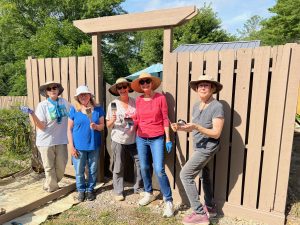
*Source: “Beaverdam Valley – A Brief Historical Perspective,” by David E. Carey.